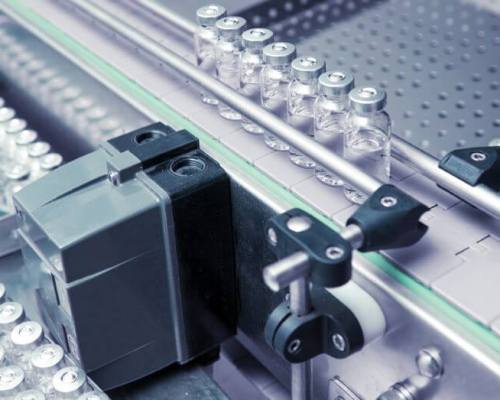Preparing Your Manufacturing Plant for the Future
Part 1: Why and How to Do an Energy Audit
For informational purposes only. Tips and sample audit documents are for consideration only. Duke Energy Sustainable Solutions is not liable for energy performance, savings or outcomes of self-administered energy audits.
This article is Part 1 of our series on optimizing your plant through energy efficiency, resiliency and renewable energy. Keep reading to learn how energy audits can help you reach your energy reduction goals and boost production efficiency. You’ll also find best practices for energy audits and a sample checklist to download.
Why are energy audits important?
This isn’t just about an aspirational push to save the planet. It’s about setting your plant up to thrive through market disruptions, extreme weather and energy prices that rise with inflation.
It’s also about attracting the next generation of talent. A recent Atlassian-commissioned survey showed that 60% of millennials surveyed who expressed concern over employment prospects would still consider leaving their job if their company didn’t align with their values. Seventy-seven percent of all millennials surveyed said companies should take responsibility for their environmental impact. They value a sustainable future. So why not attract more talent while reducing your energy costs and boosting resiliency?
Start working toward your sustainability, efficiency and resiliency goals by lowering the base energy load in your plant. When you lower your load, you’ll typically spend less on energy. And you’ll need a smaller renewable energy generation project or virtual power purchase agreement to cover that load later. You’ll also need fewer backup batteries and/or generators to protect your plant from unplanned outages as part of your resiliency strategy. Equipment that’s more energy efficient is also by definition newer and typically safer and more productive. So it’s a win-win for your energy costs, production efficiency and workforce.
How to do an energy audit on a manufacturing plant
To reduce your baseload, you’ll need to do a plant audit to find out how everything is performing and to pinpoint efficiency opportunities.
Step 1. Gather your data
They say you can’t manage what you can’t measure. It’s true. You’ll need to understand and benchmark where you are today to be able to make measurable change. To start, you’ll need to create a baseline plant profile. Do a walk-through first when your operation is underway. Observe how your team is actually using your machinery. Rarely do machines get used exactly how they were designed. Take notes. Then interview your staff about where efficiency breaks down, where they could use more light (or less), and what machines are left running when no product or workers are interacting with them.
Next, gather the rest of your data, including:
- Shop drawings
- Machine owner’s manuals
- Maintenance schedules
- Schematics of physical distribution piping and electrical conduits
- Info on control systems with critical automation
- Sequence of operations and operating schedules
- A list of other systems that consume energy and/or other resources
- Utility bills by facility
Setting aside time for assessments may be a challenge since your team already has work assignments. You may need to tap internal subject matter experts and outside consultants (like Duke Energy Sustainable Solutions), partners, vendors and suppliers who have knowledge in the opportunity areas.
Much of the audit information like equipment data and service records might already be compiled by your vendors and suppliers. And they might be willing to help as part of maintaining a good business relationship.
As you audit, we suggest you include an assessment of:
- Ventilation and pressurization systems
- Central utilities like compressed air and vacuum systems
- Water treatment and wastewater
- Building envelope, including thermal transfer points in walls and openings where insulation is needed for temperature-controlled spaces
- Utility analysis of your plant’s unique mix of water, air, gas, electric, steam or other fuels to power manufacturing processes
- Lighting systems
- Building controls
- HVAC systems
- Other central plant equipment such as chillers, boilers, steam systems, compressors and pumps
Download our sample audit checklist for areas to target and a list of possible efficiency opportunities.
Step 2. Analyze data and identify opportunities
As you go through your data, a picture will start to emerge.
Remember:
- The lowest-hanging fruit in manufacturing is simply turning off a machine when products and people aren’t interacting with it. The fix for this can be as simple as adding sensors so machines know when product is there.
- Documenting system schedules along with work shifts helps point out opportunities to trim energy use when it’s not needed.
- Keep an eye out for cogeneration opportunities. Cogeneration (also known as CHP) is great if your industry needs or produces a lot of hot water, steam or heat. CHP facilities use the byproducts of your processes to generate electricity or other resources you need. Why not get up to twice the usable energy out of the same fuel?
- Adding sensors and Wi-Fi to your production equipment will add it to the industrial internet of things (IIoT). It can give you a bird’s-eye view of each machine’s energy use and performance. It can also boost your maintenance team’s efficiency dramatically since the machines themselves can send requests for service when production goes out of specification.
Step 3. Make recommendations
Plan to complete your initial audit to coincide with planning next year’s budget. The data you gather can help decision-makers allocate capital for higher-cost equipment replacements. Your department is most likely competing with others for those funds.
Once you’ve completed your plant audit, you’ll have a road map for efficiency opportunities and the data to help sort opportunities into quick, easy fixes, and more costly opportunities that need more detailed study, engineering and modeling to drill down on the fix.
Other considerations for your manufacturing energy audit:
- Write a report of your findings and use it to build internal consensus. You’ll need to get people behind you to fund changes.
- Plan on relating any initial cost savings to net present value (NPV) and earnings per share (EPS) as well as researching any grants, utility-funded programs or tax savings that may be available. Make this a requirement for your detailed study as you’ll need this information to upsell the value of improvements to decision-makers.
- Don’t forget to include information on maintenance schedules. It’s a great place to optimize performance and extend equipment life. Lower energy usage is usually a side benefit of proper equipment maintenance.
- Recommissioning of your controls and control sequences, also called RCx or retro-commissioning, can be a great place to start for optimization projects. It’s often the best bang for your buck because it can require little or no additional parts to bring your control systems back to the correct operating parameters and identify system performance issues. There are many RCx and controls companies that provide this as a service.
- Break changes down into detailed action steps. And prioritize the ones that take the least resources and make the most impact on your energy use. You’ll want to build momentum with some visible and measurable quick wins.
- Make improvements slowly over time. This helps workers get used to changes.
- Once projects are approved and funded, assign a team member to be in charge for each step. Choose a completion date for each phase and follow through to make sure projects are completed and have the expected effect on energy usage.
An energy audit can seem intimidating, but remember, you aren’t alone. Your team on-site can help, and your vendors and suppliers can be valuable sources of information. Nowadays, many businesses are also setting environmental, social and governance (ESG) goals that include reducing energy usage and carbon emissions by defined percentages. Studies suggest that ESG performance can indicate how well a company thrives during uncertainty. So, your leadership can and should be behind you as you find ways to save energy and reduce your plant’s carbon footprint.
If you’re interested in a plant energy audit but you’d prefer to outsource it, contact Duke Energy Sustainable Solutions using the contact form at the bottom of the page.



